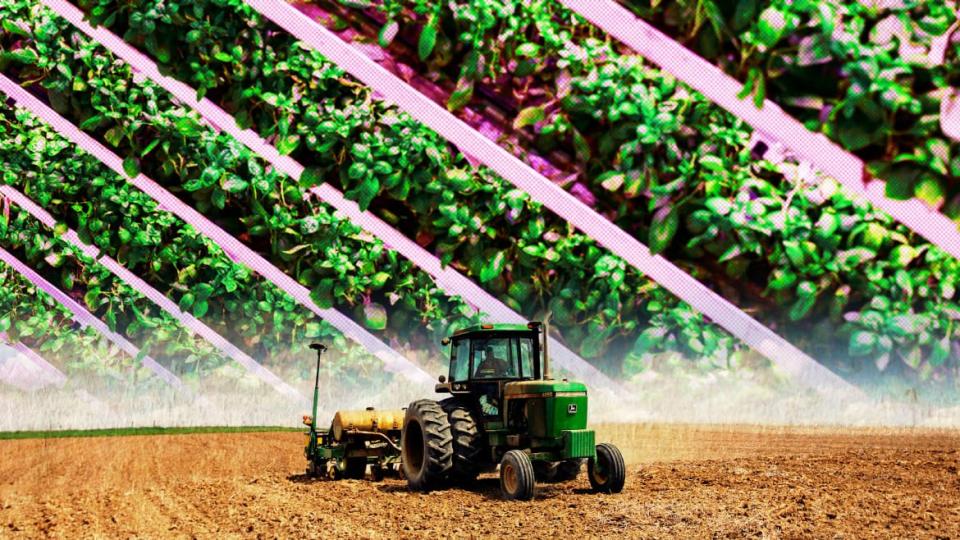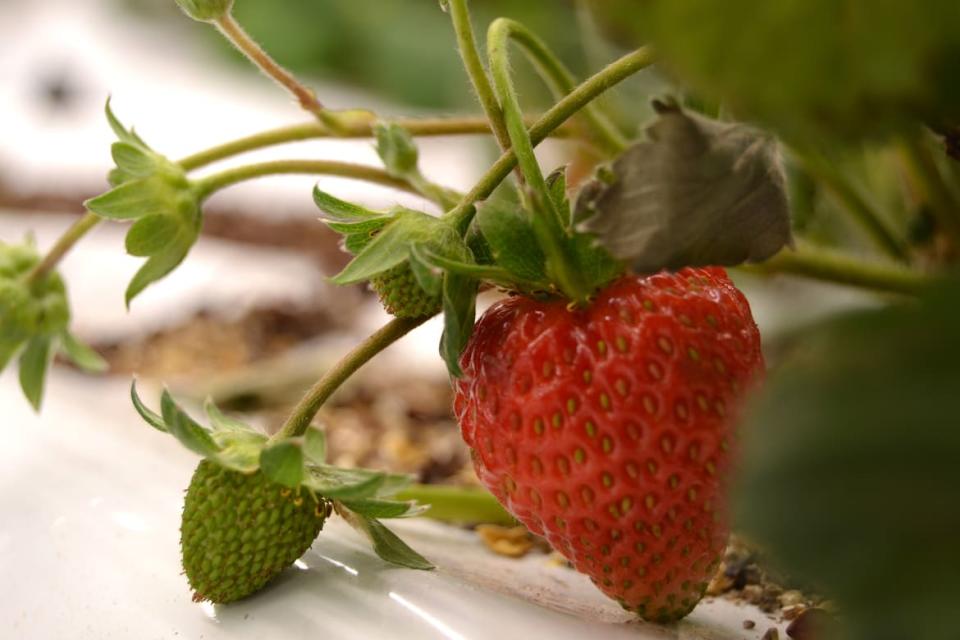Here’s the Best Way to Stop the Future Food Crisis Looming Over American Cities

When I first met Katie Seawell, she was draped head to toe with PPE. A full body suit, rubber gloves, shoe covers—the works. You’d think she was preparing to walk into a COVID unit for patients, but we were about as far away from a health-care facility as you can get, in a building located within a drab-looking office park under a bridge in Kearny, New Jersey. From the outside, it didn’t seem like there could be anything worthwhile going on here.
Inside, however, were rows and rows of fruits and vegetables on top of each other in what looked like skyscrapers of produce. I saw lettuce, radishes, mustard greens, and a whole host of other crops easily found in a local grocery store. It was what the future of food is supposed to look like—or, at least, one version of it called vertical farming. For Bowery Farms, the company that runs this project, this is a critical part of the fight to keep people fed during tumultuous changes caused by climate change and supply chain challenges. The company’s leaders see their role as growing increasingly pivotal as these issues worsen over time.
“We build farms close to the communities we are serving in and that cuts down on food miles,” Seawell, the chief commercial officer for Bowery Farms, told The Daily Beast.
One of those communities is the New York metro area, which has become a case study for what the impact of vertical farming can be and a model for how to address the elements of climate change fueled by the agricultural business.
A ‘Genetic Goldmine’ in Chile’s Desert Could Help Create New Drought-Resistant Crops
“Bowery’s journey started by answering the questions of how do you provide fresh food for an urban environment and how do that in a way that is more efficient and much more sustainable,” said Irving Fain, the company’s CEO and founder.
Bowery Farms, the largest vertical farm company in the United States, is a testament to the interest around revamping the food industry to meet sustainability goals. The company reportedly grows 80,000 pounds of produce a week, and is expanding. It recently opened a facility in Baltimore and will open another in Bethlehem, Pennsylvania.
Right now Bowery grows an array of delectable and otherwise unforgettable fruits and vegetables, including a mustard green which has a strong horseradish bite to it and sorrel that tastes exactly like an apple. It is set to introduce other new crops to the market including strawberries.

Inside Aerofarms' vertical farm facilities in New Jersey.
Bowery is far from alone. Down the road from its Kearny facility is Aerofarms, nestled on a side street blocks away from Newark Liberty International Airport. Aerofarms grows more than 500 different types of fruits and vegetables in its facilities, from arugula to baby bok choy.
Competitor Square Root is also expanding its operations but its products are more scalable since its farms use recycled shipping containers that can easily be deployed just about anywhere. They also still operate larger facilities in Michigan and around New York.
None of these companies has been slowed by the current supply chain disruptions afflicting many industries in the U.S. Vertical farming isn’t limited by the trucker, pesticide, or cardboard box shortages that hit the rest of the farming industry.
“We do seeding, growing, processing, and stage for delivery all on the farm,” Seawell says.
Super Saver
For industry experts, the appeal to vertical farming isn’t at all hard to grasp, especially as our resources dwindle over time.
Take water conservation, for instance. Conventional irrigated agriculture uses a whopping 42 percent of the country’s fresh water supply. According to Produce News, an industry trade publication, vertical farming uses 95 percent less water than conventional farming methods.
On top of that, much of this country’s mass production of fruits and vegetables comes from a handful of regions, many of which are already dealing with the impact of climate change, especially in California. Produce production accounts for up to a staggering 90 percent of water consumption in the state, but more than 80 percent of California is experiencing “extreme” or “exceptional” drought conditions. The Salinas Valley, otherwise known as America’s salad bowl—which runs through much of the state—produces half of the country’s lettuce. The region has been mired in a major drought since at least May, causing lettuce prices to rise to their highest point in 10 years.
Then there is Texas, which is suffering under seemingly opposite conditions. Earlier this year the Lone Star State was ravaged by a freak freeze and snowstorm. Farmers from every corner of the state lost their crops. It will take years for many of them to bounce back if at all.
Within vertical farms, however, crops are sheltered from extreme weather. “We are immune from this because we are able to fully control our climate,” Aerofarms co-founder Marc Oshima told The Daily Beast.
Another plus of vertical farming is that pesticides aren’t even in the equation. The extremely tight control these companies exert in the farm facilities means there are few concerns about contamination and illness caused by toxic chemicals, bugs, invasive species or vermin. Regardless, as Seawell demonstrated, these companies are not taking any chances: staff and visitors are still required to wear a full body suit with shoe covers, rubber gloves and a hairnet to limit any foreign contaminants.
Vertical farming also makes it possible for communities to have almost immediate access to produce. Facilities can be built and operated close to or even with dense urban neighborhoods. Vegetables and fruits don’t need to traverse thousands of miles from farm to grocery store and risk spoiling (food waste during transit is a contributor to the 40 percent of all food in the U.S. that ends up in landfills). Even when produce survives the journey, it can lose significant nutritional value; spinach, for instance, can lose up to 90 percent of its vitamin C nutrients within a day of harvest.

A worker at Bowery Farms shows off the lettuce beds.
It’s part of the reason New York City has become such a hotbed for innovation in this space. It’s the most populated area of the U.S. but it's also located so far away from the produce hubs of the Midwest, California and Texas. The rise of frequent superstorms like Ida and Sandy have ravaged more nearby farmlands along the East Coast. Only months ago, floods from Hurricane Ida tore through Connecticut and destroyed state crops ranging from lettuce to pumpkins. Almost 10 years ago, Hurricane Sandy flooded roughly 10 percent of New York City’s community gardens, which are a huge source for consumers looking to establish more sustainable sources of produce. Vertical farming operations simply don’t have to worry about these issues.
New York City is quickly becoming a bastion of vertical farming. Mayor-elect Eric Adams has specifically called for scaling up vertical farming operations within the city by expanding more public private partnerships with organizations to “leverage unused real estate” He also plans to update zoning laws to support further development within the city limits. In 2018, a New York City school turned a chemistry lab into a vertical farm. It produced a staggering 25,000 pounds of produce in a year, enough to feed more than 6,000 people.
New York City might be the most high profile example of how vertical farming is growing, but it’s far from the only U.S. city. Vertical farming startup Planted has found success in Detroit, and its products are sold at grocers and at restaurants around the greater Detroit metro. Plenty, based in San Francisco and with additional operations in Wyoming and in Washington as well, claims to use millions of gallons of less water every week than traditional farms.
High Bars to Clear
While these vertical farming efforts can help keep people fed while the climate gets worse, the product comes at a premium price tag that millions of Americans just cannot afford. That’s a challenge for companies like Aerofarms in particular whose products are classified as organics.
“Organics have a 20 percent premium over non-organics,” said Aerofarms’ Oshima. “Transparently, we do need that 20 percent premium to make money but our ambition is to lower prices.”
Supply chain disruptions, which have shot the price of everything from milk to beef, have only amplified this disparity.
“These methods are great alternatives to be able to grow food but right now it does not feel like they’re particularly targeted towards low income communities,” Luciano Contreras, manager of community food retail RiseBoro Community Partnerships, a non-profit that offers support services to low income families in Brooklyn, told The Daily Beast.
Contreras’s sentiment is echoed by a study run out of Cambridge University, which found that urban farming practices like vertical farming are more prevalent in a city’s wealthier communities than its poorer ones.

Vertical farms are proving capable of producing most kinds of popular produce. Here, Aerofarms shows off its strawberries.
And in the context of the global market, vertical farming’s disruptions have the potential to exacerbate disparities in the developing world as well.
One example is Aerofarms’ partnership with Cargill Cocoa in Europe, to address the water-intensive cocoa production process at a time when potable drinking water is particularly scarce. On the surface that seems like a good thing, but basing these operations in Europe will cut the need for imports to the West from Africa, where upwards of 70 percent of the world’s cocoa is grown. Aerofarms countered that its research and development relationship with Cargill will help supplement cocoa production on the Ivory Coast, which is increasingly limited and facing the effects of climate change. But that remains to be seen.
Fortunately it does look like the vertical farming footprint is expanding beyond just supplying the Whole Foods of the world. Bowery Farms is available at grocery stores across the mid-Atlantic and Northeast that include Giant Food, Walmart and Albertsons among others. Recently AeroFarms announced a new distribution partnership with Stop & Shop. InFarms, based in Germany, is working on supplying produce to Kroger stores across the U.S.
While imperfect, it does seem that vertical farming is at least part of the future of agriculture, even if it’s unexpectedly localized “in an otherwise unsuspecting office-park,” as Seawell described during my visit to Bowery Farms. Maybe it’s not as surprising as we might think. As cities begin to swell with larger populations and we start to build taller and taller buildings to accommodate everyone, it’s only natural our farms start to reach for the sky as well.
Correction: The first two images were taken at Aerofarms' facilities, not Bowery Farms. The captions have been corrected, and we regret the error.
Get our top stories in your inbox every day. Sign up now!
Daily Beast Membership: Beast Inside goes deeper on the stories that matter to you. Learn more.

 Yahoo Finance
Yahoo Finance 